You are here
CBO Warns: Deficit Drop is Temporary

Although deficits have come down since the height of the financial crisis in 2009, this trend is temporary, according to a new Congressional Budget Office (CBO) report. CBO warns that federal budget deficits will begin rising again soon, and major long-term fiscal challenges remain unaddressed. These challenges stem from a structural mismatch between spending and revenues that is driven primarily by an aging population, growing healthcare costs, rising interest costs, and a tax code that fails to generate sufficient revenues.
CBO projects that federal debt will remain at historically high levels over the next decade under current laws and warns that such high levels of debt could harm the economy:
"The large and growing federal debt would have serious negative consequences, including increasing federal spending for interest payments; restraining economic growth in the long term; giving policymakers less flexibility to respond to unexpected challenges; and eventually heightening the risk of a fiscal crisis."
Federal budget deficits will rise again soon. CBO projects that the deficit will begin rising again after just two years and climb to more than $1 trillion in 2025. Over the next 10 years, projected deficits total $7.6 trillion.
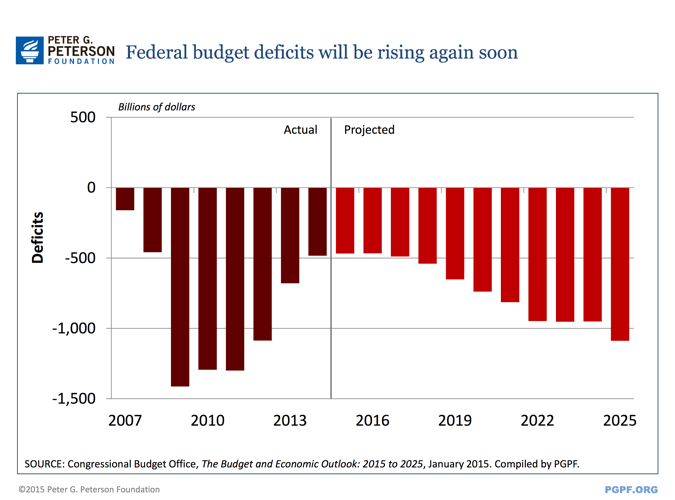
Federal debt is historically high. Although federal debt is projected to decline slightly as a share of GDP over the next few years, it begins to rise again after 2018 and reaches 79 percent of GDP in 2025. Historically, that is a very high level of debt. Since 1790, there have been only 7 years in which the debt was above 75 percent of GDP, and those were during and just after World War II. After the war, debt began to fall sharply as a share of GDP, as the economy boomed and some debt was paid down. Today, the budget outlook is much more worrisome because the projections show a dramatic increase in debt and only modest economic growth.
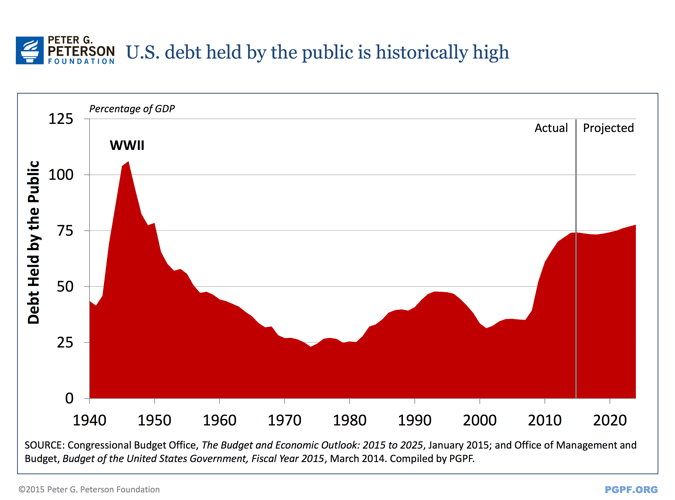
There is a continuing structural mismatch between spending and revenue. The rising annual deficits that CBO projects are the result of the growing structural gap between the federal government’s spending and the amount of revenue it collects. Over the next ten years, CBO expects that revenues will remain roughly steady at about 18.2 percent of GDP. However, spending is projected to rise over the same period, increasing from 20.3 percent of GDP in 2015 to 22.3 percent in 2025. Over ten years, CBO projects total federal spending will amount to $49.3 trillion, while total federal revenues will be only $41.7 trillion, resulting in a cumulative 10-year deficit of $7.6 trillion. Over the long term, this structural gap widens significantly.
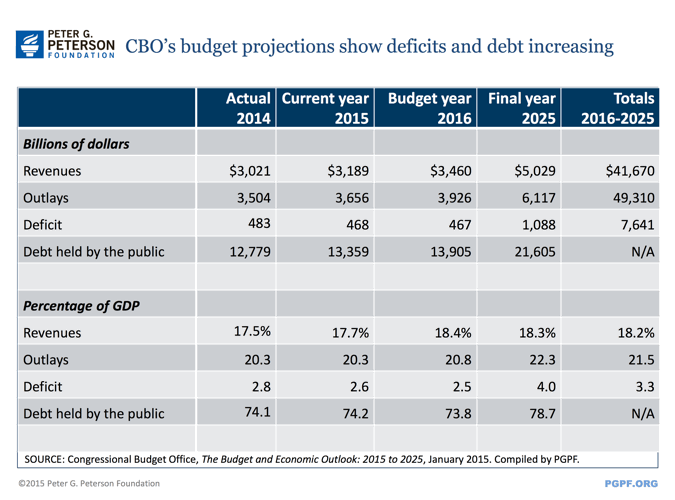
Interest costs are projected to climb due to growing debt levels and rising interest rates. As debt continues to accumulate and interest rates increase, net interest costs are projected to more than triple over the decade, soaring from $227 billion in 2015 to $827 billion in 2025. Over 10 years, interest costs total $5.6 trillion. In 2023, they are projected to become the third largest category in the budget, after Social Security and Medicare. CBO expects the rate on 10-year Treasury notes will rise from 2.6 percent in 2015 to 4.6 percent in 2025 while rates for 3-month Treasury bills are projected to climb even more dramatically, rising from 0.1 percent in 2015 to 3.4 percent in 2025.
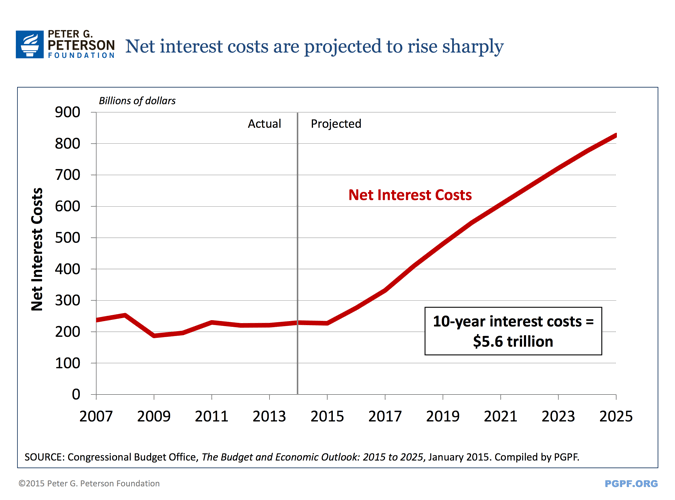
Mandatory spending is projected to climb in the coming years. Mandatory spending (excluding net interest) is expected to increase from $2.3 trillion in 2015 to $3.9 trillion in 2025. This rise is attributable primarily to increased spending for major health care programs and Social Security.
-
Major health programs: CBO projects that net spending for the major health programs will climb from $913 billion in 2015 to $1.7 trillion in 2025. That growth reflects growth in three major programs: Medicare, Medicaid, and the exchange subsidies.
- Medicare: As a growing number of baby boomers retire and costs per beneficiary increase, net spending for Medicare will rise from $523 billion in 2015 to $976 billion in 2025.
- Medicaid: Fueled by state expansion of health insurance under the Affordable Care Act, Medicaid spending is expected to rise from $335 billion in 2015 to $588 billion in 2025.
- Social Security: Spending on Social Security, currently the single largest federal program, will grow from $883 billion in 2015 to $1.6 trillion in 2025, driven primarily by the retirement of the baby boomers.
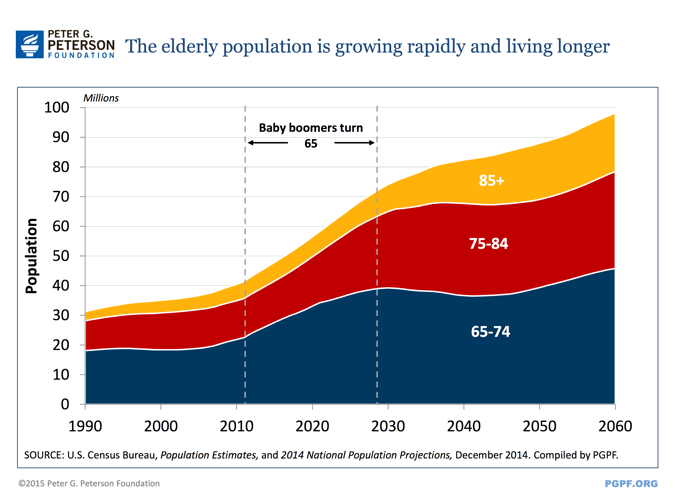
While mandatory spending and interest costs are projected to climb, federal spending devoted to discretionary programs will fall to historic lows ― from 6.5 percent of GDP in 2015 to 5.1 percent of GDP in 2025. At this level, discretionary spending would be almost 30 percent below its average over the last 20 years, and lower than it has been in any year recorded in its history. On our current path, as discretionary programs shrink relative to the size of the economy, investments in areas such as education, infrastructure, and R&D are likely to be crowded out by the growth in other programs.
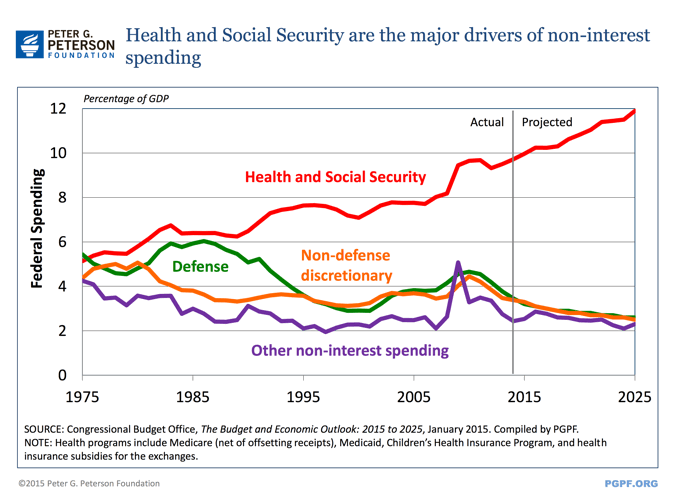
The time for policymakers to act is now. CBO’s recent report provides a stark warning that the recent trend of lower deficits will end soon, and that the country faces dangerous levels of debt in the future. CBO writes:
In its most recent long-term budget report (July 2014), CBO estimates that within 25 years debt held by the public would climb to over 100 percent of GDP under current law and to a staggering 183 percent of GDP under less optimistic assumptions. Debt at those levels would put our economic future at risk.
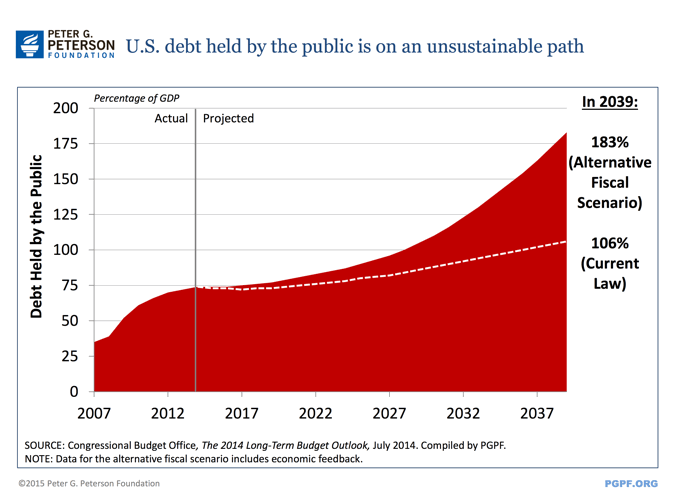
With the economy now well into a recovery, Congress and the Administration have an important opportunity to address our long-term fiscal challenges. With the upcoming release of the President’s budget in February and a deadline to pass a budget resolution in April, lawmakers should work together to build a strong fiscal foundation for our economy and for future generations of Americans.
